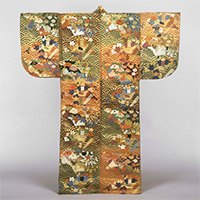能と歌舞伎 能のデザインに見る吉祥模様
-

唐織 緑紅茶段青海波花熨斗扇夕顔模様 上杉家伝来 江戸時代・18世紀
本館 9室
2019年1月2日(水) ~ 2019年2月24日(日)お正月の展示にちなみ、能装束や中啓・団扇といった小道具のデザインに表わされる吉祥模様を選び、能と吉祥模様の関係を紹介します。もともと寺社へ奉納する芸能として発達した猿楽能においては、その装束や道具に鶴・亀・松・鳳凰・雲龍・扇・熨斗といった吉祥模様が表されます。唐織や厚板といった織物や素襖の型染など、さまざまな技法で表わされた吉祥模様を通して、おめでたく華やぎに満ちた日本の伝統的な模様の世界をご覧ください。
| 指定 | 名称 | 員数 | 作者・出土・伝来 | 時代・年代世紀 | 所蔵者・寄贈者・列品番号 | 備考 | |
| 素襖 紺白染分地若松霞模様 | 1具 | 江戸時代・19世紀 | 東京・大倉集古館蔵 | ||||
| おすすめ | 重文 | 直垂 縹麻地鶴亀松竹模様 | 1領 | 安土桃山時代・16世紀 | 岐阜・春日神社蔵 | ||
| 側次 紺地雲龍模様 | 1領 | 江戸時代・18~19世紀 | 文化庁蔵 | ||||
| おすすめ | 唐織 緑紅茶段青海波花熨斗扇夕顔模様 | 1領 | 上杉家伝来 | 江戸時代・18世紀 | I-2023 | ||
| 長絹 黄地牡丹南天模様 | 1領 | 江戸時代・18~19世紀 | 文化庁蔵 | ||||
| 中啓 金地桜樹短冊模様 | 1握 | 奈良・金春家伝来 | 江戸時代・19世紀 | I-3190 | |||
| 中啓 金地老松鶴亀模様 | 1握 | 奈良・金春家伝来 | 江戸時代・18世紀 | I-3170 | |||
| 唐織 紅白段市松地牡丹鳥尽模様 | 1領 | 江戸時代・19世紀 | 東京・大倉集古館蔵 | ||||
| 厚板 藍茶段立涌笹萩模様 | 1領 | 江戸時代・18世紀 | I-1996 |
